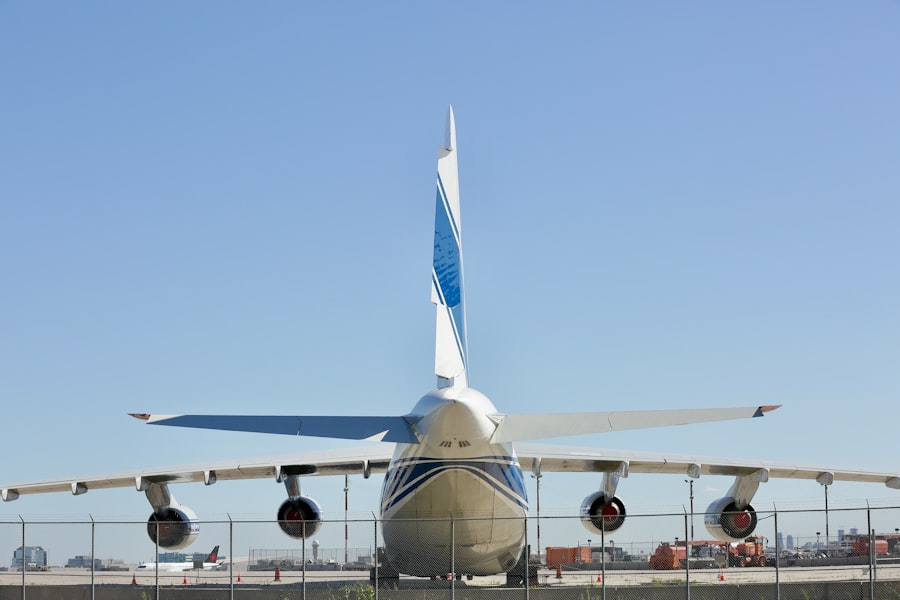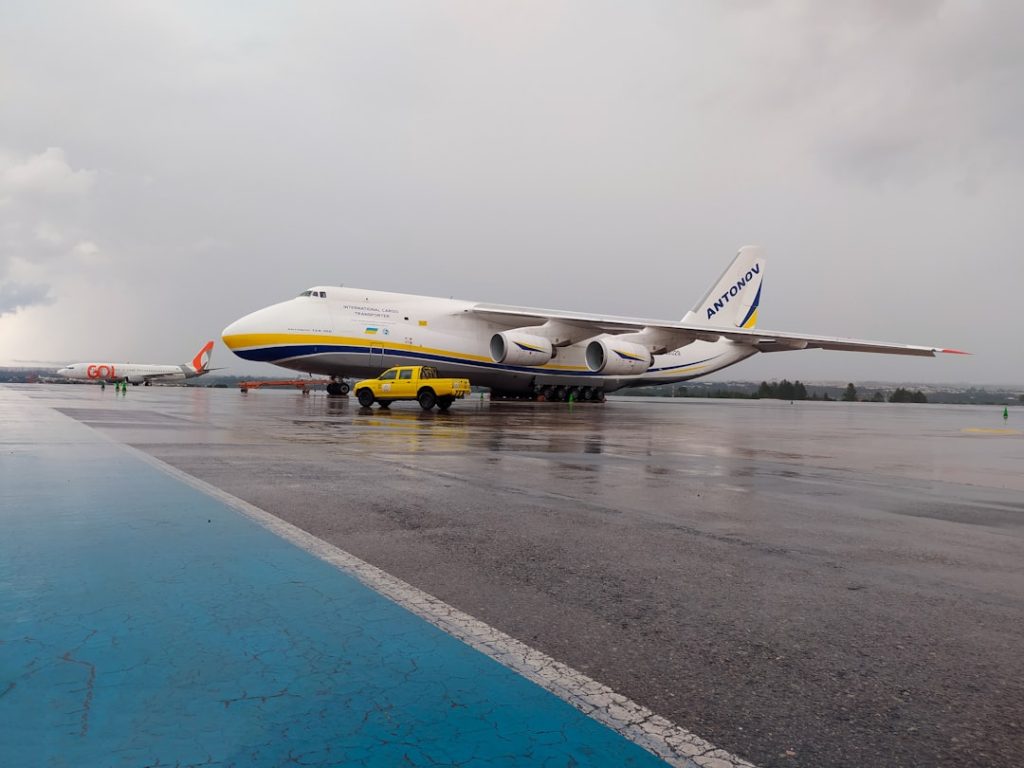The aviation industry has long been a realm of innovation and engineering marvels, with aircraft evolving from simple wooden structures to complex machines capable of traversing vast distances. Among these advancements, one aircraft stands out as a testament to human ingenuity: the Antonov An-225 Mriya. This colossal plane, originally designed in the 1980s in the Soviet Union, holds the title of the largest cargo aircraft ever built.
With its impressive wingspan and remarkable payload capacity, the An-225 has captured the imagination of aviation enthusiasts and professionals alike. Its primary purpose was to transport the Buran space shuttle, but it has since been utilized for a variety of heavy cargo missions, showcasing its versatility and engineering prowess. The An-225’s sheer size is awe-inspiring; it measures 84 meters in length and boasts a wingspan of 88.4 meters, making it longer than a football field and wider than any other operational aircraft.
This behemoth is powered by six turbofan engines, which enable it to lift enormous weights into the sky. The plane’s design reflects a unique blend of functionality and aesthetic appeal, with its distinctive nose that can be raised to facilitate loading and unloading. The An-225 is not just a marvel of engineering; it represents a significant chapter in the history of aviation, embodying the ambitions of a bygone era while continuing to serve modern needs.
Key Takeaways
- The largest plane in the world is a marvel of modern engineering and aviation technology.
- The design and construction of the plane required innovative approaches to overcome technical challenges.
- With its impressive technical specifications and capabilities, the largest plane is set to revolutionize modern aviation.
- The plane’s role in modern aviation is expected to open up new possibilities for global transportation and logistics.
- Building the largest plane presented significant challenges, but also led to groundbreaking innovations in aerospace technology.
The Design and Construction of the Plane
The design process for the Antonov An-225 was a monumental undertaking that required extensive research and development. Initiated in the early 1980s, the project aimed to create an aircraft capable of transporting large payloads, particularly for the Soviet space program. The design team at Antonov faced numerous challenges, including the need for a robust structure that could withstand the stresses of flight while accommodating oversized cargo.
The result was an aircraft that featured a unique combination of materials and engineering techniques, including a lightweight composite structure that enhanced its performance. Construction of the An-225 began in 1984, with the first flight taking place in December 1988. The assembly process was intricate, involving thousands of skilled workers and advanced manufacturing technologies.
Each component was meticulously crafted to ensure that it met the rigorous standards required for such a massive aircraft. The fuselage was designed to be spacious enough to carry oversized items, while the wings were engineered to provide optimal lift and stability during flight. The incorporation of advanced avionics and navigation systems further enhanced the aircraft’s capabilities, allowing it to operate efficiently in various conditions.
The Technical Specifications and Capabilities of the Plane

The technical specifications of the Antonov An-225 are nothing short of extraordinary. With a maximum takeoff weight of 640 metric tons, it can carry payloads that far exceed those of any other aircraft. Its cargo hold is 43 meters long and 6.4 meters wide, allowing it to accommodate items such as heavy machinery, large industrial components, and even other aircraft.
The An-225’s ability to transport such massive loads is facilitated by its six powerful Ivchenko Progress D-18T engines, which provide a thrust of approximately 229 kN each. In terms of performance, the An-225 can reach a maximum speed of around 850 kilometers per hour and has a range of approximately 15,400 kilometers when carrying lighter loads. This impressive range allows it to operate on long-haul missions without requiring frequent refueling stops.
Additionally, the aircraft is equipped with advanced navigation systems that enhance its operational capabilities, enabling it to fly in various weather conditions and navigate complex airspace with precision. The combination of these specifications makes the An-225 not only a remarkable feat of engineering but also an invaluable asset for transporting oversized cargo across the globe.
The Role of the Plane in Modern Aviation
| Aspect | Metrics |
|---|---|
| Passenger Traffic | Number of passengers carried annually |
| Cargo Transport | Volume of goods transported by planes |
| Economic Impact | Contribution to global GDP |
| Environmental Impact | Carbon emissions and fuel efficiency |
| Technological Advancements | Development of new aircraft models |
In modern aviation, the Antonov An-225 plays a crucial role in facilitating global trade and transportation. Its unique capabilities allow it to serve industries that require the movement of large or heavy items that cannot be transported by conventional means. For instance, it has been instrumental in delivering humanitarian aid during natural disasters, transporting medical supplies and equipment to regions in need.
Its ability to carry oversized cargo has also made it a preferred choice for industries such as construction, energy, and aerospace. The An-225’s versatility extends beyond commercial applications; it has also been utilized for military purposes. Various armed forces around the world have recognized its potential for transporting military equipment and supplies quickly and efficiently.
This dual-use capability underscores the importance of the An-225 in both civilian and military aviation sectors, highlighting its significance as a strategic asset in times of crisis or conflict.
Challenges and Innovations in Building the Largest Plane
Building an aircraft as large as the Antonov An-225 presented numerous challenges that required innovative solutions. One significant hurdle was ensuring structural integrity while minimizing weight. Engineers employed advanced materials such as aluminum alloys and composite materials to achieve this balance, allowing for a strong yet lightweight design.
Additionally, the sheer size of the aircraft necessitated specialized manufacturing techniques and facilities capable of accommodating its dimensions. Another challenge was developing an efficient propulsion system that could provide sufficient thrust without compromising fuel efficiency. The six-engine configuration was chosen not only for its power but also for its redundancy; if one engine were to fail, the aircraft could still operate safely with the remaining engines.
This design consideration reflects a broader trend in aviation toward enhancing safety through redundancy while pushing the boundaries of what is possible in terms of size and capability.
The Impact of the Plane on Global Transportation

The Antonov An-225 has had a profound impact on global transportation by redefining what is possible in terms of cargo capacity and logistics. Its ability to transport oversized items has opened new avenues for industries that rely on heavy machinery and equipment. For example, wind turbine components, which are often too large for standard cargo planes, can be efficiently transported using the An-225, facilitating the growth of renewable energy projects worldwide.
Moreover, the An-225 has played a vital role in emergency response efforts during natural disasters. Its capacity to deliver large quantities of humanitarian aid quickly can make a significant difference in crisis situations where time is of the essence. By providing rapid transportation solutions for essential supplies such as food, water, and medical equipment, the An-225 has become an invaluable tool for international relief organizations.
Future Developments and Potential Uses for the Largest Plane
Looking ahead, there are exciting possibilities for future developments related to the Antonov An-225 and similar large cargo aircraft. As global trade continues to expand and industries evolve, there will likely be an increasing demand for efficient transportation solutions capable of handling oversized cargo. Innovations in materials science and aerodynamics may lead to new designs that enhance performance while reducing environmental impact.
Additionally, advancements in technology could enable more efficient operations for existing aircraft like the An-225. For instance, integrating artificial intelligence into flight operations could optimize routing and fuel consumption, further enhancing its capabilities. Furthermore, as industries such as space exploration continue to grow, there may be new opportunities for utilizing large cargo planes to transport components for spacecraft or satellites.
The Legacy of the Largest Plane in the World
The Antonov An-225 Mriya stands as a symbol of human achievement in aviation engineering and design. Its legacy is not only defined by its size but also by its contributions to global transportation and logistics. As industries continue to evolve and face new challenges, the An-225 remains an essential asset capable of meeting those demands with unparalleled efficiency.
While its future may hold uncertainties due to changing market dynamics and technological advancements, its impact on aviation history is undeniable. The An-225 has set benchmarks for what is possible in cargo transport, inspiring future generations of engineers and innovators to push boundaries further. As we look toward an increasingly interconnected world, the legacy of this remarkable aircraft will undoubtedly continue to influence how we think about transportation on a global scale.


